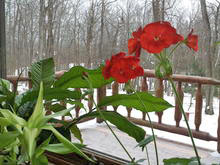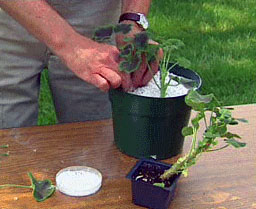Geraniums with Care Become a Multi-Season Annual
By Carolyn R. Casey, Fairfax Master Gardener
 Geraniums (Pelargonium) can easily become a multi-season annual. They can be overwintered if you know some simple and straightforward techniques. These are one of my favorite annuals and require very little care during the spring, summer and throughout the long, dark winters. In winter, placed in the right lighting or near a window, they can provide a source of enjoyment extending their beauty year round.
Geraniums (Pelargonium) can easily become a multi-season annual. They can be overwintered if you know some simple and straightforward techniques. These are one of my favorite annuals and require very little care during the spring, summer and throughout the long, dark winters. In winter, placed in the right lighting or near a window, they can provide a source of enjoyment extending their beauty year round.
Some people may not be aware that they can overwinter their geraniums. It’s easy and fun to do and does not take a lot of time or effort. You must do this before the first frost. Make sure that you have enough pots or hanging baskets and soil before you start digging up your geraniums. Prune your geraniums back by 1/3 to 1/2 and then dig them up and replant them into clean pots or hanging baskets with new potting soil. At this time, inspect your geraniums for disease and insects. I spray my plants with horticultural oil spray according to bottle directions to kill any insect eggs that are on my plants. I learned this the hard way when one year I brought in my plants that had not been sprayed, and after a while I had some insects flying and crawling in my home.
Make sure that all of your plants are in an area where it is cool and can receive direct sunlight. Periodically water them when the soil dries out. They like temperatures between 65 to 70 degrees F (18 – 21°C). The geraniums in my Florida room (with a lot of sunlight) require more frequent watering than the ones hanging at the windows in my garage.

Planting geranium cuttings
Geraniums can also be overwintered as cuttings. Use a shape knife and cut 3- to 4-inch (7 – 10 cm) stems from the terminal ends of the shoots. Cut off the lower leaves and dip the base of the cuttings into rooting hormone. Put the cuttings into a mix of vermiculite, or perlite and sphagnum moss. Place the cuttings into containers that have drainage holes in the bottom and are used as rooting containers. Once the cuttings are put in the containers, water them and allow them to drain a few minutes. Since they root best in moist and humid environments, place the containers into clear plastic bags creating a little greenhouse for your cuttings. Place the containers in an area that has bright light but is not direct sunlight. In six to eight weeks the cuttings will have rooted. Once the cuttings have good root systems, take them from the rooting medium and plant them into pots. Place the pots in a sunny area or in artificial light until you can plant them outdoors in the spring.
There is another way to overwinter geraniums. This requires that you dig up your geraniums, inspect for disease or insects and carefully remove the soil from the roots. If insects are present, spray with horticultural oil. Then place your plants in paper bags or hang them upside down in a cool dark place in an area that has a temperature between 45 to 50 degrees F (7 – 10°C). during the winter. Two or three times during the winter you will want to take your geraniums out of the paper bags or from the areas that you have them hanging upside down and soak the roots in water for 1 to 2 hours.
 After Mother’s Day or when all danger of frost has passed, depending on where you live, take your geraniums and prune out any stems and leaves that are shriveled or dead. Your plants may look sketchy but do not panic. Now you can take your geraniums outside and plant them in your outdoor containers. Place your containers where they will receive full sun. You will want to water after you plant them and use a slow release fertilizer. You can also give the plant a kick with a fertilizer that is quickly absorbed into the geraniums’ foliage. It will take a little time for your geraniums to wake up from their long winter’s nap. Once they awaken your geraniums will be just as beautiful and full as they were the previous spring and summer. They are easy to care for and require minimal watering. I do deadhead them as needed, and this stimulates new growth.
After Mother’s Day or when all danger of frost has passed, depending on where you live, take your geraniums and prune out any stems and leaves that are shriveled or dead. Your plants may look sketchy but do not panic. Now you can take your geraniums outside and plant them in your outdoor containers. Place your containers where they will receive full sun. You will want to water after you plant them and use a slow release fertilizer. You can also give the plant a kick with a fertilizer that is quickly absorbed into the geraniums’ foliage. It will take a little time for your geraniums to wake up from their long winter’s nap. Once they awaken your geraniums will be just as beautiful and full as they were the previous spring and summer. They are easy to care for and require minimal watering. I do deadhead them as needed, and this stimulates new growth.
Geraniums have come a long way from the red ones that I used to help my Dad plant in our window box and outdoor containers. They now come in a wide variety of bright and beautiful colors with attractive foliage. They are more expensive than most annual plants that are sold in the spring and summer. This is one reason to overwinter your geraniums. I learned a lot about gardening especially about annual geraniums from my wonderful Dad. We can learn so much when we take the time to listen.
Good luck overwintering your annual geraniums and Happy Gardening!
Resources
• Overwintering Geraniums, Cindy Haynes, Department of Horticulture, Iowa State University Extension
and Outreach
• How can I over-winter my geraniums indoors?, Iowa State University Extension and Outreach
• Overwintering Geraniums, Debra Stinton Othitis, Colorado State University Extension
• How To Overwinter Geraniums, Marie Iannetti, The Spruce